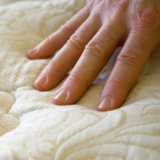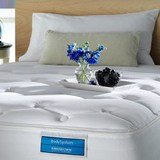Choosing the Best Foam
Latex Mattress Topper
Shopping for the best foam latex mattress topper doesn't have to be difficult or frustrating; in fact it can be relatively simple if you have done your research and have valuable information in hand.
Keep reading for information regarding helpful information such as how to know what thickness and firmness to look for, tips for finding the healthiest options, and acceptable price ranges.
Why a Foam Latex Topper?
If you struggle with chemical sensitivities, would prefer an environmentally friendly product, are frustrated with the lack of support provided by other toppers, or tend to have allergic reactions to certain bedding products, you may simply want something completely different.
These are all excellent reasons for trying a latex topper, but what should you look for?
Why Do You Need a Mattress Topper?
It's helpful to understand why you want a topper in the first place so you know what to look for when shopping.
- Does your mattress still have support? Keep in mind that if you're hoping a topper will fill in a mattress that is sagging or caved in the middle, you'll be disappointed. The topper only provides additional support over top the existing mattress. It cannot provide the support that the mattress is supposed to have already.
- Do you just need a bit more comfort? Many people looking at toppers simply want a bit more support or more of a plush feeling when they sleep. This is a good reason to buy a topper.
- Spinal alignment is key to ultimate comfort! No matter which thickness you choose, your spine should be aligned when you lie down so you're not experiencing back or neck pain in the morning. Depending on your weight, you may require a thicker topper to provide proper alignment.
- How thick is your current mattress? Make sure you will be able to fit sheets over your mattress and topper together. You'll also want to be able to get into and out of your bed safely, so check to see if you can lower your bed frame if needed.
- What's your budget? Thankfully there are wide price ranges, but it's also important to get a quality product for your money, so if possible, be willing to consider a bit of a range when it comes to price.
Thicknesses of a Latex Topper -
What's Available?
The nice thing about these toppers is that there are several thicknesses available, so you can customize your bed with just the right amount of support. The thinnest latex topper is one inch thick. The thickest ones can be 5 or 6 inches.
It's a good idea to shop around because one manufacturer might offer only 1-inch, 2-inch, and 3-inch toppers, whereas others will offer the entire range of thicknesses.
How Firm Should a Foam Latex Mattress
Topper Be?
The firmness of a latex topper is labeled with an ILD or Indentation Load Deflection rating of either 20 ILD or 32 ILD. What does this mean to you?
It's simple - the ILD rating lets you know if the topper is firmer or softer. The higher ILD number of 32 means the topper is firmer. The lower ILD number of 20 means the topper will feel less firm and more plush.
This rating translates into how well the topper will support your body. The 20 ILD is great for those looking for a bit softer feel while sleeping. The 32 ILD topper is better for those looking for additional support.
Natural vs. Synthetic Latex - Does It Matter?
Yes, it does matter! Natural latex, produced from the sap of rubber trees, contains little or no synthetic or chemical ingredients, which means it won't emit toxic gasses into your home and breathing air. Natural latex responds quickly so you can enjoy proper spinal alignment and relief from painful pressure points.
Natural latex breathes so your skin can too. You won't feel clammy or extremely hot sleeping on natural latex. It's fantastic for motion isolation, so you and your spouse won't bother each other when you adjust sleeping positions during the night.
Other benefits of natural latex are that it's naturally hypo-allergenic, resists the infestation of dust mites, and will last a lot longer than other toppers.
Synthetic latex on the other hand is produced from chemicals called petrochemicals. Yes, some manufacturers toss in some natural latex so they can market their product a bit differently, but the end result is the same, which is a chemically based product.
Synthetic latex mattress toppers will break down a lot quicker than natural latex. They tend to hold moisture and heat and could develop mold issues or potential dust mite infestations at some point.
The chemicals used to make the synthetic latex will off-gas into your breathing air, which could cause respiratory difficulties or severe allergic reactions. These chemicals smell awful too.
Dunlop vs Talalay Manufacturing Method
When you're shopping for a foam latex mattress topper, you will encounter these two terms: Talalay and Dunlop. What do these terms mean and why are they important when it comes to choosing a latex topper?
Dunlop and Talalay are the two types of manufacturing processes used to process natural latex into foam latex mattresses and foam latex mattress toppers.
The Dunlop process takes the natural rubber sap, whips it inside a centrifuge, pours it into a mold, and then bakes it using steam.
The Talalay method is similar, but after the whipped latex is poured into a mold, it is flash-frozen and sealed inside a chamber prior to the baking step.
What's the difference between these two types of foam latex mattress topper products?
Dunlop latex toppers tend to be firmer than Talalay. Talalay mattress toppers are more plush feeling and more expensive because of the additional steps. Your personal preference wins out here when it comes to choosing between the two.
Price Range for Latex Mattress Toppers
The prices for a foam latex mattress topper can range between $67 for a twin size topper up to $948 for a California King size topper.
Let's All Sleep Better
Help us to spread the word!
Simply copy and paste this code into your Facebook page or blog. Thank you for sharing!
Related Articles:



New! Comments
Share your thoughts about what you just read! Leave me a comment in the box below.